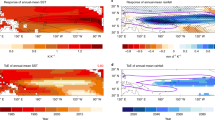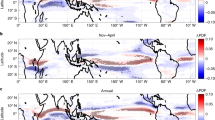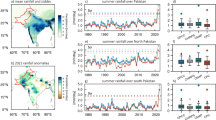Abstract
The South Pacific Convergence Zone (SPCZ) is the largest rainband in the Southern Hemisphere and provides most of the rainfall to southwest Pacific island nations. In spite of various modelling efforts, it remains uncertain how the SPCZ will respond to greenhouse warming. Using a hierarchy of climate models we show that the uncertainty of SPCZ rainfall projections in present-generation climate models can be explained as a result of two competing mechanisms. Higher tropical sea surface temperatures lead to an overall increase of atmospheric moisture and rainfall whereas weaker sea surface temperature gradients dynamically shift the SPCZ northeastward and promote summer drying in areas of the southwest Pacific. On the basis of a multi-model ensemble of 76 greenhouse warming experiments and for moderate tropical warming of 1–2 °C we estimate a 6% decrease of SPCZ rainfall with a multi-model uncertainty exceeding ±20%. For stronger tropical warming exceeding 3 °C, a tendency for a wetter SPCZ region is identified.
This is a preview of subscription content, access via your institution
Access options
Subscribe to this journal
Receive 12 print issues and online access
$209.00 per year
only $17.42 per issue
Buy this article
- Purchase on Springer Link
- Instant access to full article PDF
Prices may be subject to local taxes which are calculated during checkout





Similar content being viewed by others
References
Vincent, D. G. The South Pacific convergence zone (SPCZ): A review. Mon. Weath. Rev. 122, 1949–1970 (1994).
Kiladis, G. N., von Storch, H. & van Loon, H. Origin of the South Pacific convergence zone. J. Clim. 2, 1185–1195 (1989).
Widlansky, M. J., Webster, P. J. & Hoyos, C. D. On the location and orientation of the South Pacific Convergence Zone. Clim. Dynam. 36, 561–578 (2011).
Matthews, A. J. A multiscale framework for the origin and variability of the South Pacific Convergence Zone. Q. J. R. Meteorol. Soc. 138, 1165–1178 (2012).
Griffiths, G. M., Salinger, M. J. & Leleu, I. Trends in extreme daily rainfall across the South Pacific and relationship to the South Pacific Convergence Zone. Int. J. Climatol. 23, 847–869 (2003).
Lorrey, A., Dalu, G., Renwick, J., Diamond, H. & Gaetani, M. Reconstructing the South Pacific Convergence Zone position during the pre-satellite era: a La Niña case study. Mon. Weath. Rev. http://dx.doi.org/10.1175/MWR-D-11-00228.1 (2012).
Seager, R. et al. Air–sea interaction and the seasonal cycle of the subtropical anticyclones. J. Clim. 16, 1948–1966 (2003).
Trenberth, K. E. The definition of El Niño. Bull. Am. Meteorol. Soc. 78, 2771–2777 (1997).
Folland, C. K., Renwick, J. A. & Salinger, M. J. Relative influences of the Interdecadal Pacific Oscillation and ENSO on the South Pacific Convergence Zone. Geophys. Res. Lett. 29, 1643–1646 (2002).
Gill, A. Some simple solutions for heat-induced tropical circulation. Q. J. R. Meteorol. Soc. 106, 447–462 (1980).
Fu, X. & Wang, B. The role of longwave radiation and boundary layer thermodynamics in forcing tropical surface winds. J. Clim. 12, 1049–1069 (1999).
Lindzen, R. S. & Nigam, S. On the role of sea-surface temperature-gradients in forcing low level winds and convergence in the tropics. J. Atmos. Sci. 44, 2418–2436 (1987).
Cai, W. et al. More extreme swings of the South Pacific Convergence Zone due to greenhouse warming. Nature 488, 365–369 (2012).
Collins, M. et al. The impact of global warming on the tropical Pacific ocean and El Niño. Nature Geosci. 3, 391–397 (2010).
Ashok, K., Sabin, T. P., Swapna, P. & Murtugudde, R. G. Is a global warming signature emerging in the tropical Pacific? Geophys. Res. Lett. 39, L02701 (2012).
Knutson, T. R. & Manabe, S. Time-mean response over the tropical Pacific to increased CO2 in a coupled ocean-atmosphere model. J. Clim. 8, 2181–2199 (1995).
Liu, S., Vavrus, S., He, F., Wen, N. & Zhong, Y. Rethinking tropical ocean response to global warming: The enhanced equatorial warming. J. Clim. 18, 4684–4700 (2005).
Meehl, G. A. et al. Response of the NCAR Climate System Model to increased CO2 and the role of physical processes. J. Clim. 13, 1879–1898 (2000).
Meehl, G. A. et al. in Climate Change 2007: The Physical Science Basis (eds Solomon, S. et al.) Ch. 10 (Cambridge Univ. Press, 2007).
Xie, S-P. et al. Global warming pattern formation: Sea surface temperature and rainfall. J. Clim. 23, 966–986 (2010).
Brown, J. R., Moise, A. F. & Delange, F. P. Changes in the South Pacific Convergence Zone in IPCC AR4 future climate projections. Clim. Dynam. 39, 1–19 (2012).
Meehl, G. A. et al. The WCRP CMIP3 multimodel dataset—A new era in climate change research. Bull. Am. Meteorol. Soc. 88, 1383–1394 (2007).
Taylor, K. E., Stouffer, R. J. & Meehl, G. A. An overview of CMIP5 and the experiment design. Bull. Am. Meteorol. Soc. 93, 485–498 (2012).
Christensen, J. H. et al. in Climate Change 2007: The Physical Science Basis (eds Solomon, S. et al.) Ch. 11 (Cambridge Univ. Press, 2007).
Australian Bureau of Meteorology and CSIRO, Climate Change in the Pacific: Scientific Assessment and New Research. Volume 1: Regional Overview (2011).
Timmermann, A., McGregor, S. & Jin, F. F. Wind effects on past and future regional sea level trends in the southern Indo-Pacific. J. Clim. 23, 4429–4437 (2010).
Lin, J-L. The double-ITCZ problem in IPCC AR4 coupled GCMs: Ocean–atmosphere feedback analysis. J. Clim. 20, 4497–4525 (2007).
Brown, J. R. et al. Evaluation of the South Pacific Convergence Zone in IPCC AR4 climate model simulations of the twentieth century. J. Clim. 24, 1565–1582 (2011).
Irving, D. B. et al. Evaluating global climate models for the Pacific island region. Clim. Res. 49, 169–187 (2011).
Wittenberg, A., Rosati, A., Lau, N. & Ploshay, J. J. GFDL’s CM2 global climate models- Part 3: Tropical Pacific climate and ENSO. J. Clim. 19, 698–722 (2006).
Ashfaq, M., Skinner, C. B. & Diffenbaugh, N. S. Influence of SST biases on future climate change projections. Clim. Dynam. 36, 1303–1319 (2010).
Adler, R. F. et al. The version-2 Global Precipitation Climatology Project (GPCP) monthly precipitation analysis (1979-present). J. Hydrometeorol. 4, 1147–1167 (2003).
Collins, W. D. et al. Description of the NCAR Community Atmosphere Model (CAM 3.0) NCAR/TN–464+STR (National Center for Atmospheric Research, 2004).
Chou, C., Neelin, J. D., Chen, C-A. & Tu, J-Y. Evaluating the Rich-Get-Richer mechanism in tropical precipitation change under global warming. J. Clim. 22, 1982–2005 (2009).
Manganello, J. V. & Huang, B. The influence of systematic errors in the Southeast Pacific on ENSO variability and prediction in a coupled GCM. Clim. Dynam. 32, 1015–1034 (2008).
Molteni, F. Atmospheric simulations using a GCM with simplified physical parametrizations. I: Model climatology and variability in multi-decadal experiments. Clim. Dynam. 20, 175–191 (2003).
Jha, B. & Kumar, A. A comparison of the atmospheric response to ENSO in coupled and uncoupled model simulations. Mon. Weath. Rev. 137, 479–487 (2009).
Graham, N. E. & Barnett, T. P. Sea surface temperature, surface wind divergence, and convection over tropical oceans. Science 238, 657–659 (1987).
Johnson, N. C. & Xie, S-P. Changes in the sea surface temperature threshold for tropical convection. Nature Geosci. 3, 842–845 (2010).
Vincent, E. M. et al. Interannual variability of the South Pacific Convergence Zone and implications for tropical cyclone genesis. Clim. Dynam. 36, 1881–1896 (2011).
Seager, R., Naik, N. & Vecchi, G. A. Thermodynamic and dynamic mechanisms for large-scale changes in the hydrological cycle in response to global warming. J. Clim. 23, 4651–4668 (2010).
Held, I. M. & Soden, B. J. Robust response of the hydrological cycle to global warming. J. Clim. 19, 5686–5699 (2006).
Ma, J., Xie, S-P. & Kosaka, Y. Mechanisms for tropical tropospheric circulation change in response to global warming. J. Clim. 25, 2979–2994 (2012).
Lintner, B. & Neelin, J. Eastern margin variability of the South Pacific Convergence Zone. Geophys. Res. Lett. 35, L16701 (2008).
Takahashi, K. & Battisti, D. Processes controlling the mean tropical Pacific precipitation pattern. Part II: The SPCZ and the Southeast Pacific Dry Zone. J. Clim. 20, 5696–5706 (2007).
Acknowledgements
This work was supported by the Office of Science (BER) US Department of Energy, Grant DE-FG02-07ER64469, by the US National Science Foundation under grant 1049219 and by the Japan Agency for Marine-Earth Science and Technology (JAMSTEC). S.M. and M.H.E. were supported by the Australian Research Council. M.L. was supported by the Institut de Recherche pour le Developpement. W.C. was supported by the Australian Climate Change Science Program and the CSIRO Office of Chief Executive Science Leader programme. We acknowledge the World Climate Research Programme’s Working Group on Coupled Modelling, which is responsible for CMIP, and we thank the climate modelling groups for producing and making available their model output. The KNMI Climate Explorer, Netherlands, provided CMIP data from their Web site at http://climexp.knmi.nl/. We acknowledge the International Centre for Theoretical Physics, Italy, for hosting an influential workshop on Hierarchical Modelling of Climate and providing the ICTP idealized atmospheric GCM.
Author information
Authors and Affiliations
Contributions
The paper was written by M.J.W., A.T. and K.S. Experiments were carried out by M.J.W., A.T., K.S. and S.M. All authors contributed to interpreting the results, improving the methodology and refining the paper.
Corresponding author
Ethics declarations
Competing interests
The authors declare no competing financial interests.
Supplementary information
Supplementary Information
Supplementary Information (PDF 2285 kb)
Rights and permissions
About this article
Cite this article
Widlansky, M., Timmermann, A., Stein, K. et al. Changes in South Pacific rainfall bands in a warming climate. Nature Clim Change 3, 417–423 (2013). https://doi.org/10.1038/nclimate1726
Received:
Accepted:
Published:
Issue Date:
DOI: https://doi.org/10.1038/nclimate1726
This article is cited by
-
Climate processes and drivers in the Pacific and global warming: a review for informing Pacific planning agencies
Climatic Change (2023)
-
Emergence of climate change in the tropical Pacific
Nature Climate Change (2022)
-
Increasing ENSO–rainfall variability due to changes in future tropical temperature–rainfall relationship
Communications Earth & Environment (2021)
-
Fine-scale rainfall over New Caledonia under climate change
Climate Dynamics (2021)
-
Scope for predicting seasonal variation of the SPCZ with ACCESS-S1
Climate Dynamics (2021)



